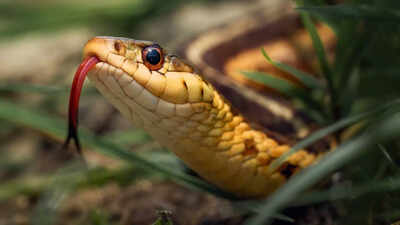
Snakes tend to be feared because of the way they look and the threat posed by venomous snakes. Nonetheless, most snakes that pose in backyards and gardens are not venomous and serve an important function in preserving the health of local environments.
They serve as nature's pest control, preying on rodents, insects, and small mammals that would otherwise cause harm or disease. A single snake can devour several mice in one sitting, keeping rodent populations under control without the use of toxic chemicals or traps.Snakes are creepy visitors, but they do not necessarily have to be dangerous. Knowing their actions, habitat, and what can draw them near is what keeps their visits safe, green, and humane.
According to Northwest Exterminating, home remedies usually suffice in keeping them away, but never shy away from consulting professionals if and when needed. Proper planning can ensure your abode stays safe while nature performs its role.
Home ingredients that keep snakes away
Naphthalene (Mothballs)
- Widely found in commercial repellents
- Contained in mothballs, which may be left in cracks and snake-infested areas
- Caution: Naphthalene is poisonous if swallowed by children or pets. Exercise great care.
Sulfur powder
- Causes irritation of the skin in snakes
- Spread around the perimeter of your home or yard
- Has a pungent smell, so use a mask when applying
Clove and cinnamon oil
- Successful when used together and sprayed on the snake or in strategic spots
- May be placed in indoor diffusers for additional protection
- Take caution! Spraying can get the snake to run in unsuspecting directions
Garlic and onion
- Effective in that they have sulfonic acid, which bothers snakes
- Combine crushed onion and garlic with rock salt and spread around the house
- Can also be added to oil and applied to fumigation
Ammonia
- Snakes are repelled by the strong smell
- Spray directly or wet a cloth and place in unsealed bags near snake points of entry
Vinegar
- Effective on waterside situations such as pools, ponds, or garden fountains
- Pour white vinegar around these areas to create a natural repellent ring
Lime with peppermint or chili
- Snakes are repelled by the odour and skin irritation produced by lime blends
- Combine lime with peppermint oil or hot chili powder and pour along the perimeter of the house
Effective ways to remove what attracts’ snakes
Remove the food chainSnakes don't appear out of thin air. They are attracted by available prey, including:
- Mice and rats
- Frogs and birds
- Insects, voles, moles, and even fish
To discourage snakes, first eliminate or control these infesting populations. With the food source removed, snakes will seek alternative terrain for more fertile hunting grounds.
Eliminate hiding placesSnakes prefer hiding in dark, cold, and moist places. Typical hiding spots are:
- Creases in foundations or walls
- Spaces around pipes or vents
- Heaps of leaves, mulch, wood, and compost
What you can do:
- Close up entry points in the exterior of your home.
- Replace or fix torn screens, leaky gutters, or broken vents.
- Clean your yard of debris, excess mulch, and piled wood.
- Keep firewood in raised or closed containers to avoid nesting.
Landscape for preventionOne of the most effective deterrents for snakes is a well-maintained yard.Proactive landscaping suggestions:
- Mow your lawn frequently to remove ground-level cover.
- Fill in holes or cover burrows where snakes can hide.
- Use snake-proof fencing constructed from steel mesh or plastic sheeting:
- Should be a minimum of 3 feet tall and 4 feet deep.
- Should be sloped outward so that snakes cannot climb up.
- Install coarse ground cover (such as gravel, holly leaves, or eggshells) to make snakes uncomfortable.
Employ smoke as a natural barrierSnakes possess a highly sensitive sense of smell. One thing they despise? Smoke.How to employ:
- Light a small fire pit and allow it to smolder for days.
- Moss and leaves spread over burning embers to enhance production of smoke.
- Most effective in enclosed or semi-enclosed outdoor areas such as sheds or under decking.
When and why snakes come out: Temperature, timing, and seasonal patterns
Preferred temperature rangesSnakes are cold-blooded animals, relying on outside heat to maintain their body temperature. They become more active when temperatures outside are between 80°F and 90°F (27°C to 32°C)—usually during spring and summer.Daily activity patternsDuring hot weather, snakes are most active in the early morning and late afternoon, avoiding the intense heat of midday. You’re less likely to see them during the peak sun hours because excessive heat can be just as dangerous for them as cold.Seasonal behaviour: Hibernation and brumationAs temperatures cool in late fall, snakes prepare for hibernation or brumation, a dormant-like state common in warmer climates. During brumation:
- Snakes don't sleep but slow down their activity significantly.
- Their metabolism decelerates, saving energy.
- On a warm winter day, brumating snakes can come out briefly to soak up some sunlight, sometimes surprising people who think snakes don't move in winter.
When to call the experts
If after trying the above, the snakes continue to come back, it might be time to call an expert in wildlife or pest control. Experts can:
- Determine the species of snake
- Humanely trap and remove the creatures
- Provide permanent exclusion solutions
- Assist in resolving underlying causes, i.e., a rodent problem, which continues to draw snakes
Why to use home remedies instead of chemicals to keep away snakes
Using natural methods of repelling snakes has numerous benefits:
- Accessibility: Ingredients are usually already available at home or at any general store.
- Cost-effectiveness: Home remedies are significantly less expensive than pest control services or commercial repellents.
- Ease: The majority of remedies involve simple application methods.
- Safety: Natural repellents tend to be non-toxic and safer for kids, pets, and wildlife.

 7 hours ago
36
7 hours ago
36




























 English (US)
English (US)